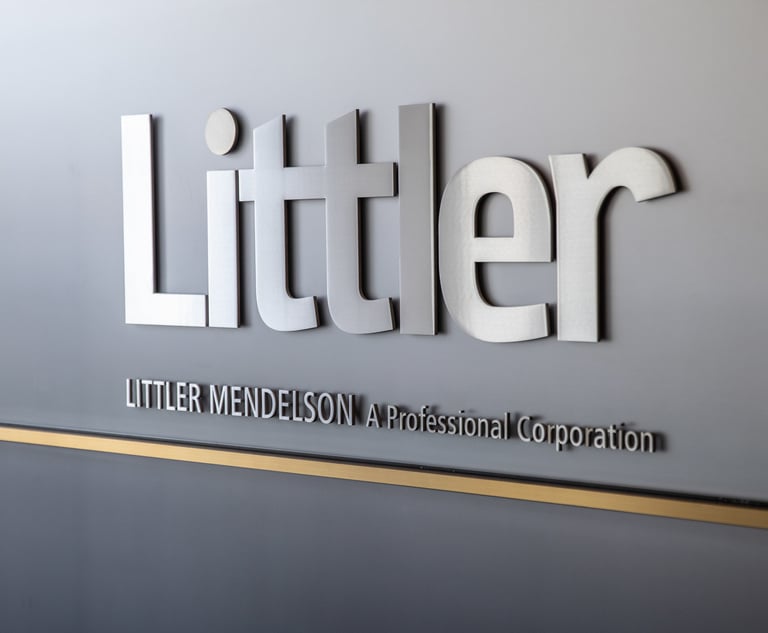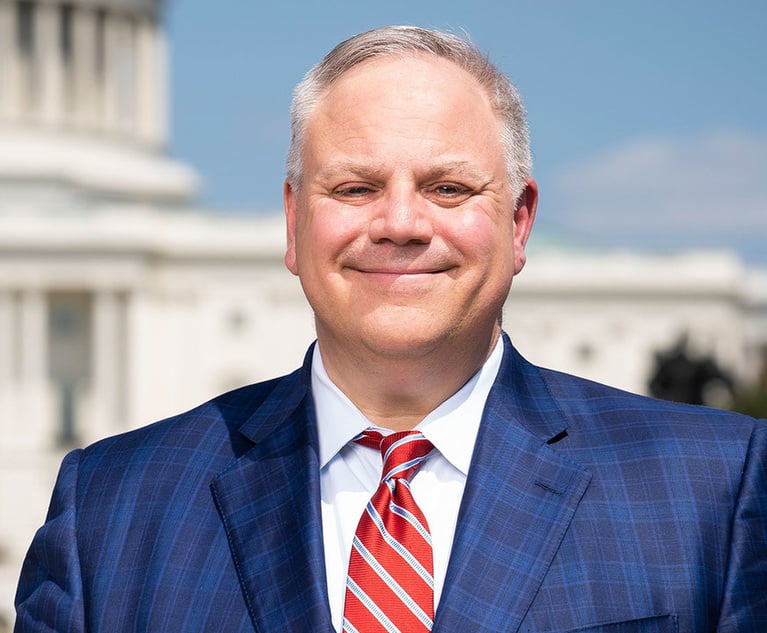'It's Coming': Looming Recession Keeps Bankruptcy Partners on the Move
The early warnings have been hard to miss, especially compared to the last big downturn. And law firms are taking heed.
October 29, 2019 at 03:43 PM
6 minute read
 (Image: Shutterstock)
(Image: Shutterstock)
After the debt bubble burst a dozen years ago, a cascade of business failures turned bankruptcy practices into a bright spot—and set off a rush for talent—among law firms grappling with the Great Recession.
But firms don't want to be playing catch-up when the next major recession hits.
Data on partner moves, combined with interviews with lawyers, recruiters and consultants, show that firms have been remarkably proactive in building up their bankruptcy practices over the last three years, energizing the lateral market long before the arrival of the anticipated downturn. With two months still remaining in 2019, the year has already ushered in more lateral moves than in both 2017 and 2018.
Every law firm that legal recruiting firm Major, Lindsey & Africa has visited has cited growing its bankruptcy practice as a top priority, according to founder Jon Lindsey. He said lateral movement in the practice area will likely reach its peak in the next year, but that the timing has been different than in recessions past.
"The demand for restructuring and bankruptcy partners is as dynamic as it's been in the last 25 years," he said. "Firms in the past waited until a wave hit to look for a lifeboat. Now, the sense that they need to have people in place before the storm hits is much more acute."
More than a decade after the last recession, threats to the economy's health are slowly becoming apparent as more indicators point to an imminent slowdown. But unlike the sudden worldwide financial crisis of the last decade, the slow plod toward the next recession has allowed law firms to be more deliberative in building out their bankruptcy and restructuring practices.
Lindsey emphasized that the U.S. is not in a recession right now, but in light of global economic concerns, trade disputes with China and other factors, "it's coming—and there's a lot of work to be done."
For firms that have maintained strong restructuring practices, the benefits aren't hard to see. Recent bankruptcy matters involving Sears, Pacific Gas & Electric, Toys R Us and other struggling industry leaders have generated staggering fees for Kirkland & Ellis, Weil, Gotshal & Manges, Cravath, Swaine & Moore, Jenner & Block and other firms.
Others are taking note, and are using the current pre-slowdown lull to deepen their benches.
From Jan. 1, 2019, through the end of October, there have already been 533 lateral moves involving bankruptcy and restructuring attorneys, according to ALM Intelligence data tracking U.S.-based partners, associates and of counsels joining Am Law 200 firms. This is compared to 413 moves in 2018 and 364 in 2017.
Although lateral hires across practices areas increased from 2017 to 2018, overall lateral activity has slowed in 2019 as bankruptcy moves have boomed, the ALM Intelligence figures show.
Firms are keen to snap up attorneys with valuable industry relationships that can lead to windfall cases in the financially difficult years to come, said Ross Weil of Walker Associates.
"Relationships are coveted by firms, and corporate clients are really key," he said. Weil added he has also noticed increased competition for coveted laterals, a trend he sees continuing for the next year to year and a half. Most firms are still touting record profits from a period of sustained economic prosperity, giving them greater means to entice lateral hires and integrate them into a firm well in advance of a busy season.
Lately, firm leadership has been transparent about how fears of a recession have upped appetites for more bankruptcy attorneys. The head of McDermott Will & Emery's restructuring and insolvency group said he thinks an economic downturn is already beginning—which is why the firm has added six partners to its practice recently, including two notable hires from Skadden, Arps, Slate, Meagher & Flom and King & Spalding.
Gibson, Dunn & Crutcher in October also fortified its bankruptcy group with three creditor-side attorneys hired away from Jones Day, one of whom was co-head of Jones Day's business restructuring and reorganization practice and will co-lead the bankruptcy team at Gibson Dunn. The news came just days after Jones Day's other restructuring group co-chair departed for Debevoise & Plimpton.
Other recent bankruptcy lateral moves include Cristine Pirro Schwarzman, who jumped from Kirkland & Ellis to Ropes & Gray; three attorneys, including a new restructuring practice head, who moved to Morgan, Lewis & Bockius; and a former Kirkland partner now at Mayer Brown.
Jon Truster, co-head of lateral partner placement at Greene Levin Snyder, pointed out that as the brick-and-mortar retail economy continues to suffer, there will be more work across that sector—and not just on the debtor side—opening doors for firms that are not Big Law stalwarts.
"Large, debtor-side practices are able to throw a massive amount of resources [at a client] all at once, and you have to have a huge practice to do that at a big firm," he said, adding that this is only one slice of bankruptcy work. By improving offerings to creditors and other stakeholders, he said that many firms can still build out a successful restructuring practice.
Consultant Mary K Young of Zeughauser Group added that firms don't have to silo new hires to restructuring if a major matter has yet to materialize. In different periods of the economic cycle, the right hires will ideally lend their expertise to other practice areas, which, in turn, can make their restructuring practice even stronger.
"[Restructuring] is a countercyclical practice, and some firms have had success in the ability to flex between corporate and restructuring," she said. "A significant bankruptcy practice can be slow when business are expanding, and firms that are forward-thinking are trying to find synergy between practices areas for the clients' sake."
Read More
Will Law Firms Be Ready When the Next Recession Hits?
This content has been archived. It is available through our partners, LexisNexis® and Bloomberg Law.
To view this content, please continue to their sites.
Not a Lexis Subscriber?
Subscribe Now
Not a Bloomberg Law Subscriber?
Subscribe Now
NOT FOR REPRINT
© 2025 ALM Global, LLC, All Rights Reserved. Request academic re-use from www.copyright.com. All other uses, submit a request to [email protected]. For more information visit Asset & Logo Licensing.
You Might Like
View All

Three Akin Sports Lawyers Jump to Employment Firm Littler Mendelson

Brownstein Adds Former Interior Secretary, Offering 'Strategic Counsel' During New Trump Term
2 minute read
Trending Stories
- 1How ‘Bilateral Tapping’ Can Help with Stress and Anxiety
- 2How Law Firms Can Make Business Services a Performance Champion
- 3'Digital Mindset': Hogan Lovells' New Global Managing Partner for Digitalization
- 4Silk Road Founder Ross Ulbricht Has New York Sentence Pardoned by Trump
- 5Settlement Allows Spouses of U.S. Citizens to Reopen Removal Proceedings
Who Got The Work
J. Brugh Lower of Gibbons has entered an appearance for industrial equipment supplier Devco Corporation in a pending trademark infringement lawsuit. The suit, accusing the defendant of selling knock-off Graco products, was filed Dec. 18 in New Jersey District Court by Rivkin Radler on behalf of Graco Inc. and Graco Minnesota. The case, assigned to U.S. District Judge Zahid N. Quraishi, is 3:24-cv-11294, Graco Inc. et al v. Devco Corporation.
Who Got The Work
Rebecca Maller-Stein and Kent A. Yalowitz of Arnold & Porter Kaye Scholer have entered their appearances for Hanaco Venture Capital and its executives, Lior Prosor and David Frankel, in a pending securities lawsuit. The action, filed on Dec. 24 in New York Southern District Court by Zell, Aron & Co. on behalf of Goldeneye Advisors, accuses the defendants of negligently and fraudulently managing the plaintiff's $1 million investment. The case, assigned to U.S. District Judge Vernon S. Broderick, is 1:24-cv-09918, Goldeneye Advisors, LLC v. Hanaco Venture Capital, Ltd. et al.
Who Got The Work
Attorneys from A&O Shearman has stepped in as defense counsel for Toronto-Dominion Bank and other defendants in a pending securities class action. The suit, filed Dec. 11 in New York Southern District Court by Bleichmar Fonti & Auld, accuses the defendants of concealing the bank's 'pervasive' deficiencies in regards to its compliance with the Bank Secrecy Act and the quality of its anti-money laundering controls. The case, assigned to U.S. District Judge Arun Subramanian, is 1:24-cv-09445, Gonzalez v. The Toronto-Dominion Bank et al.
Who Got The Work
Crown Castle International, a Pennsylvania company providing shared communications infrastructure, has turned to Luke D. Wolf of Gordon Rees Scully Mansukhani to fend off a pending breach-of-contract lawsuit. The court action, filed Nov. 25 in Michigan Eastern District Court by Hooper Hathaway PC on behalf of The Town Residences LLC, accuses Crown Castle of failing to transfer approximately $30,000 in utility payments from T-Mobile in breach of a roof-top lease and assignment agreement. The case, assigned to U.S. District Judge Susan K. Declercq, is 2:24-cv-13131, The Town Residences LLC v. T-Mobile US, Inc. et al.
Who Got The Work
Wilfred P. Coronato and Daniel M. Schwartz of McCarter & English have stepped in as defense counsel to Electrolux Home Products Inc. in a pending product liability lawsuit. The court action, filed Nov. 26 in New York Eastern District Court by Poulos Lopiccolo PC and Nagel Rice LLP on behalf of David Stern, alleges that the defendant's refrigerators’ drawers and shelving repeatedly break and fall apart within months after purchase. The case, assigned to U.S. District Judge Joan M. Azrack, is 2:24-cv-08204, Stern v. Electrolux Home Products, Inc.
Featured Firms
Law Offices of Gary Martin Hays & Associates, P.C.
(470) 294-1674
Law Offices of Mark E. Salomone
(857) 444-6468
Smith & Hassler
(713) 739-1250









